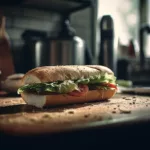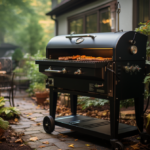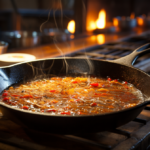Table of Contents
Building a Solid Foundation: Mastering the Basics in Cooking with Confidence
Hey there, aspiring chefs and kitchen rookies! Are you ready to embark on a culinary adventure and become a kitchen superstar? Well, you’ve landed on the right page! Welcome to Cooking with Confidence: The Essential Guide for New Cooks, where we’re here to boost your kitchen skills and turn you into a confident cook.
Cooking can sometimes feel intimidating, especially if you’re new to the game. But fear not, because this guide is designed precisely to help you overcome those initial hurdles and pave the way to culinary greatness. Whether you’re a college student wanting to impress your friends with homemade meals or a busy professional looking to expand your repertoire beyond takeout, we’ve got you covered.
Our mission is simple: to provide you with all the necessary tools, techniques, and tips to conquer any recipe with confidence. From understanding basic kitchen terms and essential cooking equipment to mastering fundamental cooking methods and flavor combinations, we’ve curated a collection of foolproof advice and recipes that will make your time in the kitchen a breeze.
But this guide is more than just a list of instructions. We want to inspire and empower you to explore your culinary creativity. Get ready to unleash your inner foodie as we delve into various cuisines, explore innovative ingredient substitutions, and share time-saving hacks that will make you the envy of your friends and family.
So grab your apron, sharpen your knives, and get ready to embark on this flavorful journey. Together, we’ll transform you from a hesitant cook into a confident culinary artist! Let’s get cooking!
Essential Kitchen Tools Every New Cook Should Have
When it comes to equipping your kitchen, having the right tools on hand can make all the difference in your cooking experience. As a new cook, it’s important to start with the essentials that will set you up for success. Here are the must-have kitchen tools that will make your culinary journey a breeze:
- Chef’s Knife: A reliable and sharp chef’s knife is the holy grail of kitchen tools. Invest in a high-quality one that feels comfortable in your hand and can handle various cutting tasks with ease.
- Cutting Board: A sturdy and spacious cutting board is essential for slicing, dicing, and chopping ingredients. Look for one made of wood or plastic, which is easy to clean and gentle on your knife’s edge.
- Measuring Cups and Spoons: Accurate measurements are crucial in cooking, so investing in a set of measuring cups and spoons is a no-brainer. They come in handy when following recipes and ensure your dishes turn out just right.
- Non-Stick Pans: These versatile pans are a lifesaver when it comes to cooking eggs, sautéing vegetables, or frying up delicate proteins. Their non-stick surface helps prevent food from sticking and makes cleanup a breeze.
- Saucepan and Stockpot: Having a saucepan, typically with a lid, and a stockpot in your arsenal will open up a world of culinary possibilities. From boiling pasta and simmering sauces to making soups and stocks, these pots are essential for stovetop cooking.
- Baking Sheet: Perfect for roasting vegetables, baking cookies, or making sheet pan dinners, a sturdy baking sheet is a must for every aspiring cook. Look for one with a non-stick surface or line it with parchment paper for easy cleanup.
- Whisk: Whip up smooth sauces, salad dressings, and baked goods with a trusty whisk. Its wire loops help incorporate air into liquids, resulting in fluffy and well-blended mixtures.
These essential kitchen tools will get you started on your cooking journey and provide a solid foundation for future culinary adventures. As you gain confidence and experience, you can gradually expand your collection to include specialized gadgets and appliances. Remember, cooking should be fun and enjoyable, and having the right tools makes all the difference. So, gear up with these essentials, and let your culinary creativity soar!
The Joy of Sharing: Bringing People Together Through Food
One of the most beautiful aspects of cooking is the ability to bring people together. Whether it’s a family gathering, a friendly get-together, or a special occasion, the act of sharing food creates a sense of joy and connection. Here’s why the joy of sharing is an essential aspect of cooking with confidence:
So, savor the joy of sharing! Cook with love, invite others to share in your culinary creations, and relish the moments spent around the table. Let food be a catalyst for laughter, conversation, and connection. By sharing the fruits of your labor, you create a ripple effect of happiness, leaving a lasting imprint on the lives of others. Cook with confidence and embrace the transformative power of sharing food!
Mastering Basic Knife Skills: The Foundation of Cooking
When it comes to cooking, one of the most essential skills to master is knife work. Proper knife skills not only make your cooking more efficient but also enhance the presentation and texture of your dishes. Here’s a breakdown of the basic knife skills every new cook should strive to master:
- Grip and Hold: Start by holding the knife with a firm but relaxed grip. Wrap your fingers around the handle and rest your thumb on the side of the blade for control and stability.
- Rock and Chop: The rocking motion is essential for slicing and dicing. Practice the rocking motion by placing the tip of the knife on the cutting board, lifting the back of the blade, and moving it in a smooth, downward rocking motion.
- Slice and Dice: For slicing, use a smooth motion and let the weight of the knife do the work. Keep your fingers curled in a claw shape to protect them. For dicing, begin with a slice, then move your non-cutting hand fingers back to guide the knife through the food, creating consistent pieces.
- Julienne and Mince: To julienne, first, create even slices, then stack them and cut into matchstick-like strips. For mincing, use a rocking motion while holding the tip of the knife against the cutting board, then repeatedly chop until the desired fineness is achieved.
- Sharpen and Maintain: A sharp knife is safer and more effective in the kitchen. Regularly sharpen your knife using a honing steel or a whetstone. Additionally, take care of your knife by handwashing it and storing it in a knife block or sheath to maintain its sharpness and longevity.
By mastering basic knife skills, you’ll not only save time but also enjoy the cooking process more. You’ll be able to create precise cuts for even cooking and beautiful presentations. Remember, practice makes perfect, so start by mastering one skill at a time and incorporate it into your cooking routine. With time and patience, you’ll become a confident cook with the power to create stunning dishes that are both visually appealing and delicious. So, grab your knife and start honing those skills – the kitchen is your canvas!
Understanding Common Cooking Terms: From Sauteing to Braising
Understanding Common Cooking Terms: From Sautéing to Braising
Cooking is like a language of its own, with a wide range of terms and techniques. As a new cook, understanding common cooking terms is essential for following recipes and executing them with confidence. Here are some terms to get you started:
- Sautéing: This cooking method involves quickly cooking ingredients in a hot pan with a small amount of oil or butter. It’s perfect for browning vegetables, searing meats, or creating flavorful stir-fries.
- Simmering: Simmering refers to cooking food in a liquid at a temperature just below the boiling point. It is ideal for gentle cooking, allowing flavors to meld and develop slowly. Soups, stews, and sauces often require simmering.
- Braising: Braising involves browning meat or vegetables in a pan and then slowly cooking them in a covered pot with a small amount of liquid. This method results in tender and flavorful dishes, such as pot roasts and braised vegetables.
- Grilling: Grilling involves cooking food over direct heat, typically on an outdoor grill, creating those distinctive charred marks. It’s perfect for foods like burgers, kebabs, and vegetables.
- Baking: Baking is a dry heat cooking method typically done in an oven. It’s used for cookies, cakes, bread, and other baked goods, creating delicious treats with a golden exterior and tender interior.
- Boiling: Boiling refers to cooking food in a liquid at a temperature where bubbles rapidly form and rise. It’s commonly used for boiling pasta, blanching vegetables, and cooking grains.
- Mince: Mincing is the process of finely chopping ingredients into tiny, uniform pieces. It’s often used for garlic, herbs, and shallots, allowing them to distribute flavor more evenly throughout a dish.
Understanding these common cooking terms will make it easier for you to follow recipes and create fantastic dishes. Feel free to explore and experiment with different techniques, adapting them to suit your own personal taste. With time and practice, you’ll become fluent in the language of cooking and unleash your culinary creativity with confidence!
From Measuring to Mise en Place: Organization in the Kitchen
Organization is the secret ingredient to cooking with confidence. Having a well-organized kitchen ensures a smooth and enjoyable cooking experience. Here are some essential aspects of organization to consider in the kitchen:
- Measuring: Accurate measurements are crucial in cooking, especially when following recipes. Keep measuring cups and spoons readily accessible, and if possible, invest in a digital kitchen scale for precise measurements.
- Mise en Place: Mise en place is a French term meaning “everything in its place.” It refers to prepping and organizing all your ingredients before you start cooking. Chop vegetables, measure out spices, and arrange everything you need. This helps you stay organized and focused during the cooking process.
- Clear Countertops: Keep your countertops clear and clutter-free. This creates a clean workspace and allows you to navigate the kitchen with ease. Put away unnecessary gadgets and appliances, only keeping out the tools you require for your current recipe.
- Storage Solutions: Utilize storage solutions to keep your kitchen organized. Use drawer inserts to separate utensils, racks to hold pots and pans, and shelves to maximize vertical space. Label containers and jars for easy identification and find a dedicated space for each item.
- Cleaning Routine: Maintain a regular cleaning routine to keep your kitchen spotless. Wash dishes as you go, wipe down surfaces, and sweep or vacuum the floor after cooking. A clean kitchen not only creates a pleasant environment but also fosters efficiency.
- Effective Refrigerator/Fridge Organization: Keep your fridge organized to avoid wasting food. Designate areas for different food categories, like fruits, vegetables, dairy products, and condiments. Label leftovers with dates for easy reference and discard expired items regularly.
An organized kitchen allows you to work efficiently, find ingredients easily, and focus on the joy of cooking. By implementing these organizational tips, you’ll create a space that nurtures your culinary creativity and instills confidence in your cooking skills. So, tidy up, declutter, and let your organized kitchen be the canvas for your delicious creations!
The Art of Seasoning: Enhancing Flavors in Your Dishes
Seasoning is the secret ingredient that can take your dishes from good to phenomenal. As a new cook, understanding how to properly season your food is essential for creating flavorful meals. Here are some tips to master the art of seasoning:
- Salt: Salt is the most fundamental seasoning that enhances the natural flavors of ingredients. Remember to season your dishes with salt at different stages of cooking, layering the flavors for optimal taste. Start with a little, taste, and add more if needed.
- Pepper: Black pepper adds a subtle heat and depth to your dishes. Grind fresh black pepper directly into your recipes rather than using pre-ground pepper for the best flavor. Be cautious with the amount, as pepper can quickly overpower other flavors.
- Herbs: Fresh or dried herbs can bring freshness and complexity to your cooking. Experiment with different herbs like basil, thyme, rosemary, or cilantro. Add herbs near the end of cooking for a more vibrant flavor or use them as a garnish to add a final touch.
- Spices: Spices are the key to adding warmth and depth to your dishes. Explore a variety of spices such as cumin, paprika, cinnamon, or turmeric to enhance your recipes. Be mindful of the intensity of spices and adjust accordingly to your desired taste.
- Acidic Ingredients: Acidic ingredients like vinegar, citrus juice, or wine can brighten flavors and balance richness. Use them sparingly to add a tangy or acidic note to your dishes. Drizzle a bit of lemon juice or vinegar over finished dishes for that extra zing.
- Taste as You Go: The key to perfect seasoning is tasting your food along the way. Regularly sample your dishes while cooking and adjust the seasonings accordingly. Remember that flavors can intensify during cooking, so it’s better to start with a lighter hand and add more if needed.
By mastering the art of seasoning, you’ll be able to create well-balanced and delectable dishes. Practice, experimentation, and trusting your taste buds are essential to developing your seasoning skills. So, don’t be afraid to get a little adventurous, try new combinations, and let your personal palate guide you on the path to becoming a confident cook who can tantalize taste buds with perfectly seasoned meals!
Exploring Essential Cooking Methods: Saute, Roast, Boil, and More
Knowing different cooking methods is like having a toolbox full of techniques that can bring out the best flavors in your ingredients. Here are some essential cooking methods every new cook should be familiar with:
- Sautéing: Sautéing involves quickly cooking food in a small amount of oil or butter over high heat. It’s perfect for browning vegetables or searing meat, creating delicious caramelization and adding depth of flavor.
- Roasting: Roasting allows you to achieve a crispy and golden exterior while retaining moisture inside the food. By cooking in the dry heat of an oven, you can roast vegetables, meats, and even fruits, developing rich flavors and tender textures.
- Boiling: Boiling is a method of cooking food in liquid at a temperature where bubbles rapidly form and rise. It’s commonly used for cooking pasta, boiling vegetables, or making broths. Boiling helps retain moisture while imparting flavors to the ingredients.
- Steaming: Steaming is a gentle and healthy cooking method that uses the steam generated from boiling water to cook food. Steaming preserves the natural flavors, colors, and nutrients of ingredients like vegetables, fish, and dumplings.
- Grilling: Grilling adds a smoky and charred flavor to your food, making it perfect for meats, vegetables, and even fruits. Whether using a charcoal grill or a stovetop grill pan, grilling can give your dishes a delightful smoky essence.
- Baking: Baking takes place in an oven, using dry heat to cook food evenly from the outside to the inside. It is commonly used for cakes, bread, cookies, and casseroles, providing a golden crust and tender interior.
- Stir-frying: Stir-frying involves quickly cooking small, bite-sized ingredients in a hot pan or wok with constant stirring. This high-heat method is perfect for creating quick and flavorful stir-fries with vibrant colors and textures.
By exploring these essential cooking methods, you gain the versatility to create an array of dishes. Experiment with different techniques, adjust cooking times and temperatures, and remember to taste your creations along the way. Each method offers unique flavors and textures, allowing you to showcase your creativity while developing confidence in the kitchen. So, grab your apron and start exploring these cooking methods to take your culinary skills to the next level!
Building a Flavorful Pantry: Must-Have Ingredients for Every Cook
A well-stocked pantry is the backbone of any successful cook. Having essential ingredients at your fingertips allows for endless possibilities and ensures you can whip up delicious meals at any time. Here are the must-have items to keep in your pantry:
- Oils and Vinegars: Stock up on a variety of oils like olive oil, vegetable oil, and sesame oil. These are fundamental for cooking, sautéing, and dressings. Don’t forget about vinegars such as balsamic, red wine, and rice vinegar, which add tang and depth to your dishes.
- Herbs and Spices: Build a collection of dried herbs like oregano, basil, thyme, and rosemary. Spice it up with ground spices like cumin, paprika, cinnamon, and chili powder. These seasonings are the pillars of flavor and can elevate any recipe.
- Canned Goods: Keep a stock of canned items like diced tomatoes, tomato paste, beans, and coconut milk. These pantry superheroes come in handy for creating sauces, stews, and quick meals in a pinch.
- Stocks and Broths: Having a variety of stocks and broths, whether homemade or store-bought, is essential. Chicken, beef, and vegetable stocks add depth and richness to soups, stews, and risottos.
- Grains and Pasta: Fill your pantry with versatile grains like rice, quinoa, and couscous. They form the base of many dishes and can be easily dressed up with different flavors. Pasta, of all shapes and sizes, is also a go-to for quick, comforting meals.
- Flour and Baking Essentials: All-purpose flour, baking powder, baking soda, and sugar are baking essentials to have on hand for sweet treats and homemade bread. Don’t forget to keep yeast and cornstarch in your pantry too.
- Condiments and Sauces: Never underestimate the power of condiments and sauces. Mustard, ketchup, soy sauce, Worcestershire sauce, and hot sauce can transform ordinary dishes into something extraordinary.
By building a flavorful pantry, you give yourself a solid foundation for culinary creativity. These staple ingredients will help you tackle any recipe with ease and experiment with exciting flavor combinations. Remember to regularly check and replenish your pantry items to ensure freshness. With a well-stocked pantry, you’ll have the confidence to create delicious meals and flavor-packed dishes that will impress family and friends. So stock up, get cooking, and let the magic of your pantry unfold!
Unlocking the Secrets of Successful Meal Planning
Meal planning is a superpower that can transform your cooking experience and help you approach meals with confidence. Here are essential tips to unlock the secrets of successful meal planning:
- Plan Ahead: Dedicate some time each week to plan your meals. Look for recipes, consider your schedule, and decide what you want to cook. Write it down or use a meal planning app to keep your plan visible and accessible.
- Consider Variety: Incorporate a variety of flavors, cuisines, and ingredients into your meal plan. This keeps things interesting and prevents mealtime boredom. Experiment with different proteins, vegetables, grains, and spices to create a diverse range of meals.
- Shop with Purpose: Based on your meal plan, create a grocery list with all the necessary ingredients. Stick to the list while shopping to avoid impulse purchases. Shopping with purpose ensures you have all the ingredients you need and eliminates last-minute trips to the store.
- Prep in Advance: Take advantage of downtime by prepping ingredients in advance. Chop vegetables, marinate meats, or cook grains ahead of time. This prep work saves you time and effort during the week, making it easier to cook meals on busy days.
- Batch Cooking and Freezing: Prepare large batches of meals or ingredients that can be frozen for later use. Soups, sauces, and casseroles can be portioned and frozen, providing quick and convenient meals for days when you’re short on time or energy.
- Stay Flexible: While meal planning provides structure, it’s important to stay flexible. Don’t feel obligated to stick rigidly to your plan if unexpected events arise or if you simply change your mind. Meal planning should make your life easier, not add stress.
- Leftover Repurposing: Get creative with leftovers by transforming them into new meals. Leftover roasted chicken can become chicken salad, and extra cooked vegetables can be incorporated into omelets or stir-fries. Repurposing leftovers reduces food waste and saves you time and money.
Successful meal planning is a personalized process that takes time to develop. Experiment, adjust, and find a routine that works best for you. With practice, meal planning will become second nature, allowing you to approach cooking with confidence, save time, and enjoy delicious meals day after day. So, grab a pen, get inspired, and start unlocking the secrets of successful meal planning!
Kitchen Safety: Tips to Keep You and Your Food Safe
Safety should be a top priority in the kitchen. Practicing good kitchen safety not only protects you but also ensures that your food is safe to consume. Here are essential tips to keep in mind:
- Cleanliness: Start by ensuring a clean kitchen. Wash your hands thoroughly before handling food, clean cooking surfaces, and utensils, and regularly sanitize countertops and cutting boards. This helps prevent cross-contamination and the spread of bacteria.
- Proper Food Storage: Store perishable items like meat, dairy, and leftovers in the refrigerator at the correct temperature. Keep raw and cooked foods separate to avoid cross-contamination. And remember, when in doubt, throw it out!
- Safe Thawing: Thaw frozen foods properly to minimize bacterial growth. Thaw in the refrigerator, use the defrost function on your microwave, or place sealed items in cold water. Avoid leaving perishable foods at room temperature for extended periods.
- Fire Safety: Keep a fire extinguisher within reach and understand how to use it. Never leave cooking unattended, and be cautious of flammable materials like kitchen towels and curtains. In case of a grease fire, turn off the heat and smother the flames with a lid or baking soda.
- Knife Safety: Practice proper knife safety by holding the knife securely, using a stable cutting surface, and employing the correct cutting techniques. Always store knives in a designated block or sheath, and keep them out of reach of children.
- Oven and Stovetop Safety: Use oven mitts when handling hot pots, pans, or baking trays. Be mindful of hot surfaces on stovetops and ovens. Turn handles inward to prevent accidental spills, and turn off burners or the oven when not in use.
- Handling Hot Liquids: Take caution when working with hot liquids like boiling water or hot oil. Use long-handled utensils to minimize the risk of burns and scalds. Be careful around steam and use oven mitts or pot holders to protect your hands.
- Electrical Safety: Ensure your kitchen’s electrical outlets are in good condition and are not overloaded. Keep cords away from water and use appliances according to their intended purpose. Regularly inspect wires and plugs for any signs of damage.
By following these safety guidelines, you can create a safer and more secure cooking environment. Treat kitchen safety as an integral part of your cooking routine, and you’ll have peace of mind while creating delicious meals. So, make safety a habit, be cautious, and enjoy the process of cooking with confidence!
Adventurous Cooking: Experimenting with Different Cuisines
Cooking is a thrilling adventure that allows you to explore flavors, cultures, and traditions from around the world. By embracing the spirit of adventurous cooking, you can expand your culinary horizons and create extraordinary dishes. Here’s why experimenting with different cuisines is an essential aspect of cooking with confidence:
- Culinary Exploration: Trying new cuisines opens up a world of flavors and ingredients you may not have encountered before. From aromatic spices in Indian cuisine to the delicate balance of flavors in Japanese dishes, each cuisine has its own unique charm and story to tell.
- Global Inspiration: Exploring different cuisines can inspire and ignite your creativity in the kitchen. You may discover new techniques, ingredients, or flavor combinations that you can incorporate into your own cooking style, allowing you to bring a touch of global influence to your dishes.
- Flavor Pairing: By experimenting with different cuisines, you gain a deeper understanding of complementary flavors. You might find that a spicy Thai curry pairs beautifully with a cooling cucumber salad or that the tartness of a Mexican salsa cuts through the richness of grilled meats.
- Breaking Boundaries: Being adventurous in the kitchen challenges you to step out of your comfort zone and try new things. It pushes you to be bolder and more open-minded, helping you break free from repetitive cooking routines and discover exciting and unexpected flavors.
- Cultural Appreciation: Exploring different cuisines allows you to appreciate and honor diverse cultures. Immersing yourself in the culinary traditions of a culture builds empathy and understanding, connecting you to people from different backgrounds through the universal language of food.
So, dive into the world of adventurous cooking! Experiment with recipes from various cuisines, venture into new spice aisles at the grocery store, and expand your culinary repertoire. Let the flavors of different cultures inspire and influence your cooking style, empowering you to create innovative and unforgettable dishes. Remember, cooking should bring joy and excitement, so let your imagination run wild in the kitchen and cook with confidence!
Mastering Recipes: Following Directions and Making Adjustments
Recipes are like roadmaps that guide you through the cooking process, but mastering them involves more than just following directions. Here are some key aspects to keep in mind when it comes to recipes:
- Read the Recipe: Before diving into a recipe, take the time to thoroughly read through it from start to finish. Understand the ingredients, cooking techniques, and equipment required. This will help you visualize the process and prepare accordingly.
- Follow Directions: Pay attention to the details. Follow the recipe’s measurements, cooking times, and instructions. Precision in cooking can make a significant difference in the final outcome.
- Be Flexible: While it’s important to initially follow the recipe, don’t be afraid to make adjustments based on your preferences or dietary needs. Cooking is an art, and recipes can serve as a springboard for your creativity.
- Ingredient Substitutions: If a recipe calls for an ingredient you don’t have or don’t enjoy, try to find suitable substitutions. For example, if you don’t have buttermilk, you can make a substitute by adding lemon juice or vinegar to regular milk.
- Taste and Adjust: Don’t be afraid to taste as you go and make adjustments accordingly. Recipes are a guide, but your taste buds have the final say. If something feels lacking, adjust the seasoning, acidity, or sweetness to suit your palate.
- Take Notes: Keep a record of your modifications and personal preferences by jotting down notes on the recipe or in a separate cooking journal. This allows you to fine-tune recipes over time and create your own go-to versions.
By mastering the art of following recipes while making adjustments when necessary, you gain the confidence to navigate the kitchen with flair. Recipes provide structure and guidance, but they shouldn’t stifle your creativity. Embrace the freedom to tailor recipes to your taste, experiment with flavors, and make each dish truly your own. Cooking becomes not only about preparing food but also about expressing your unique culinary style. So, cook with confidence, trust your instincts, and let the recipes be a canvas for your culinary artistry!
Conclusion
Cooking with confidence is a journey that starts with the willingness to explore, learn, and embrace the joy of the culinary world. It’s about arming yourself with essential skills, knowledge, and a sprinkle of adventurous spirit. Throughout this essential guide, we’ve covered a range of aspects that will guide new cooks towards developing their culinary expertise and confidence.
From mastering basic techniques and understanding essential kitchen tools to exploring flavors, experimenting with different cuisines, and even embracing the joys of sharing food with others, each aspect is a vital ingredient in the recipe for cooking with confidence.
Remember, cooking is a process of continuous learning and growth. Embrace both successes and failures, as they are stepping stones to honing your skills and developing your unique style in the kitchen. Whether you’re following recipes or making your own adjustments, trust your instincts and let your taste buds guide you.
With practice, an open mind, and a dash of creativity, you’ll soon find yourself cooking with confidence, delighting your loved ones with delicious meals, and creating your own culinary masterpieces. So, tie on your apron, gather your tools, and embark on this exciting journey of becoming a confident cook. Bon appétit!









